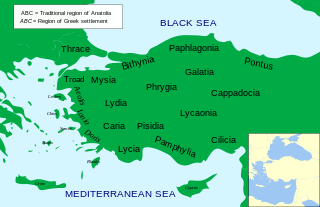
Marcus Opellius Macrinus was a Roman emperor who reigned from April 217 to June 218, jointly with his young son Diadumenianus. Born in Caesarea, in the Roman province of Mauretania Caesariensis to an equestrian family of Berber origins, he became the first emperor who did not hail from the senatorial class and also the first emperor who never visited Rome during his reign. Before becoming emperor, Macrinus served under Emperor Caracalla as a praetorian prefect and dealt with Rome's civil affairs. He later conspired against Caracalla and had him murdered in a bid to protect his own life and succeeded Caracalla as emperor.
The 200s decade ran from January 1, 200, to December 31, 209.
The 160s decade ran from January 1, 160, to December 31, 169.
The 170s decade ran from January 1, 170, to December 31, 179.
The 180s decade ran from January 1, 180, to December 31, 189.
The 190s decade ran from January 1, 190, to December 31, 199.
Year 195 (CXCV) was a common year starting on Wednesday of the Julian calendar. At the time, it was known in Rome as the Year of the Consulship of Scrapula and Clemens. The denomination 195 for this year has been used since the early medieval period, when the Anno Domini calendar era became the prevalent method in Europe for naming years.
The 210s decade ran from January 1, 210, to December 31, 219.
The 220s decade ran from January 1, 220, to December 31, 229.
The 230s decade ran from January 1, 230, to December 31, 239.
The 240s decade ran from January 1, 240, to December 31, 249.
The 250s was a decade that ran from January 1, 250, to December 31, 259.
The 260s decade ran from January 1, 260, to December 31, 269.

Year 278 (CCLXXVIII) was a common year starting on Tuesday of the Julian calendar. At the time, it was known as the Year of the Consulship of Probus and Lupus. The denomination 278 for this year has been used since the early medieval period, when the Anno Domini calendar era became the prevalent method in Europe for naming years.

Year 211 (CCXI) was a common year starting on Tuesday of the Julian calendar. At the time, in the Roman Empire it was known as the Year of the Consulship of Terentius and Bassus. The denomination 211 for this year has been used since the early medieval period, when the Anno Domini calendar era became the prevalent method in Europe for naming years.
Year 214 (CCXIV) was a common year starting on Saturday of the Julian calendar. At the time, it was known as the Year of the Consulship of Messalla and Suetrius. The denomination 214 for this year has been used since the early medieval period, when the Anno Domini calendar era became the prevalent method in Europe for naming years.
Year 218 (CCXVIII) was a common year starting on Thursday of the Julian calendar. At the time, it was known as the Year of the Consulship of Severus and Adventus. The denomination 218 for this year has been used since the early medieval period, when the Anno Domini calendar era became the prevalent method in Europe for naming years.

Julia Maesa was a member of the Severan dynasty of the Roman Empire who was the grandmother of emperors Elagabalus and Severus Alexander, elder sister of empress Julia Domna, and mother of Julia Soaemias and Julia Mamaea. She wielded influence during the reigns of her grandsons as Augusta of the Empire from 218 to her death, especially on their elevation to emperors.

The Battle of Antioch was fought between the Roman army of the Emperor Macrinus and his rival Elagabalus, whose troops were commanded by General Gannys, probably a short distance from Antioch. Gannys' victory over Macrinus led to the downfall of the emperor and his replacement by Elagabalus.
The Battle of Nisibis was fought in the summer of 217 between the armies of the Roman Empire under the newly ascended emperor Macrinus and the Parthian army of King Artabanus IV. It lasted for three days, and ended with a bloody Parthian victory, with both sides suffering large casualties. As a result of the battle, Macrinus was forced to seek peace, paying the Parthians a huge sum and abandoning the invasion of Mesopotamia that Caracalla had begun a year before.




